[Note by CEP: in the federal legislation that began to formulate the “smart grid”, there was no wireless mentioned, nor is there any mention of mandatory smart meters.
Conspicuously absent is safety, though security is mentioned. This legislation was written and technologies hastily assembled to allow utilities to receive federal grant money, starting within 2 years of this law.
Combining haste, lack of concern for safety and health, greed, and stupidity, we now have an immense, 4.7 million dollar technological mistake the taxpayers have paid for, with billions more that utility customers are being charged for, that will cost additional billions to undo.]
“Key Legislation
The Energy Independence Act of 2007 (EISA)
The first of the Federal government laws concerning the Smart grid was enacted by Congress in 2007 and is entitled The Energy Independence Act of 2007, or (EISA). EISA’s primary focus from a Smart Grid perspective is found in Title 13 [p. 292-310] of the law which is directed towards the goal of modernizing the nation’s electricity transmission and distribution system. To this goal 10 topic areas are addressed in the law, they include:
- Increased use of digital information and controls technology to improve reliability, security, and efficiency of the electric grid.
- The dynamic optimization of grid operations and resources, with full cyber-security.
- The Deployment and integration of distributed resources and generation, including renewable resources.
- Development and incorporation of demand response, demand-side resources, and energy-efficiency resources.
- Deployment of ‘‘smart’’ technologies (real-time, automated, interactive technologies that optimize the physical operation of appliances and consumer devices) for metering, communications concerning grid operations and status, and distribution automation.
- Integration of ‘‘smart’’ appliances and consumer devices.
- Deployment and integration of advanced electricity storage and peak-shaving technologies, including plug-in electric and hybrid electric vehicles, and thermal-storage air conditioning.
- Provision to consumers of timely information and control options.
- Development of standards for communication and interoperability of appliances and equipment connected to the electric grid, including the infrastructure serving the grid.
- The Identification and lowering of unreasonable or unnecessary barriers to adoption of smart grid technologies, practices and services.”
from http://smartgrid.ieee.org/resources/public-policy/united-states


Comments are closed.